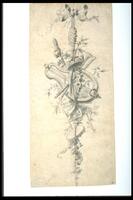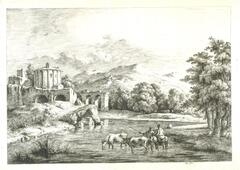Early Modern European Architecture and Interior Design
Renaissance architecture and interior design was characterized above all by a revival of the architectural features and styles of Imperial Rome. As an interest in the classical world spread northward throughout the learned society of Europe in the 15th and 16th centuries, architects and classical scholars studied and eventually began to mimic the remaining ruins of the Roman Empire. Though they “posed as imitators of the ancients,”1 however, early modern architects were also innovators. They created new types of buildings like urban palaces, theaters, and concert spaces. During this time, the structure of the home also transformed dramatically; middle- and upper-class urban homes developed from one- or two-room dwellings attached to shops into detached properties with separate functional rooms like parlors and individual bedrooms. At almost every socio-economic level, therefore, early modern people were finding new ways to transform the architectural spaces around them.2
The new idealized styles of the 15th and 16th centuries were concerned primarily with proportion, symmetry, geometry, and order.3 These qualities provided more than simple visual appeal. In fact, the greatest architectural projects of the early modern era – the urban palaces of the Medici family, the reconstruction of St. Peter’s Basilica, the re-design of the medieval city of Paris by King Henry IV, the concentric canals of Amsterdam – were all funded by powerful individuals and governments who believed that orderly architecture would foster an orderly population. Geometrically-proportioned architecture, particularly in government buildings and palaces, promoted an image of power which was regulated, methodical, and in harmony with natural law.4 By contrast, Renaissance artists were also fascinated by ruins, which indicated precisely the opposite qualities and, where they appeared in Renaissance art, often indicated moral, social, or economic decay.
This series of resources combines architectural renderings, design sketches, stage sets, and drawings of interior spaces, as well as a selection of photographs of Renaissance-era buildings. It represents the broad range of early modern conceptions of architecture and interior design across Western Europe.
Sources:
[1] Georges Gromort. Italian Renaissance Architecture. Translated by George F. Waters. London: J. Tiranti & Co. 1922.
[2] Christopher Friedrichs. The Early Modern City, 1450-1750. London: Longman, 1995.
[3] Jacob Burckhardt. The Architecture of the Italian Renaissance. Chicago: Edited by Peter Murray. University of Chicago Press, 1985.
[4] Josef Konvitz. Cities & the Sea: Port City Planning in Early Modern Europe. Baltimore: John Hopkins University Press, 1978.
6 Items in this Learning Collection
6 Links
Created For
K-12 EducatorK-12 Student
Museum Visitor
UMMA Docent
UMMA Staff
University Faculty
University Student
Rate this Learning Collection
AVG: 0 | Ratings: 0
& Author Notes
All Rights ReservedLast Updated
May 4, 2020 10:04 a.m.Report
Reporting Policy






